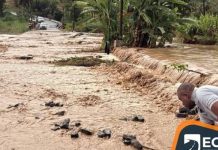By SARA ALMEIDA
Africa-Press – Cape verde. How many are there, where are they, who are they and how are Cape Verdeans spread across the world? These are questions that the Diaspora Mapping project, as has already been announced, aims to answer. The project was officially launched today, January 24th, and the first results of this great undertaking are expected to be presented by the National Statistics Institute (INE) in December 2025. Elga Tavares, INE technician, explains how this process will be carried out .
There are more Cape Verdeans outside Cape Verde than in the archipelago. The common phrase actually resonates with the observed reality. It is estimated that more than 750,000 four-generation Cape Verdeans live in the United States alone. Next comes Portugal, where more than 360,000 Cape Verdeans are believed to live. And then France, Angola, São Tomé and Príncipe…
These are data that were recently advanced by the Minister of Communities, Jorge Santos. This estimate therefore exists. But Cape Verde wants more concrete, in-depth, systematized and permanent data on its people spread across the world.
What do you want
The Strategic Plan for Sustainable Development (PEDS II) takes a “new vision on the diaspora” and dictates its Strategic Objective 4 the implementation, among others, of the “Cape Verdean Diaspora – A centrality” program.
Now, “one of the goals foreseen within the scope of this program is”, precisely, “to study and understand the profile of Cape Verdean communities abroad”, as explained by Elga Tavares, coordinator of the Census and Special Surveys Division at INE.
In this sense, last June a Resolution was published in the BO that approved the beginning of a mapping process, which defines its characteristics and which gives INE, as the body producing official statistics in the country, powers to execute this project .
“The aim is to choose data for the production of official statistics within the scope of the National Statistical System, in order to make it possible to understand the sociodemographic, economic profile and geographic distribution of the Cape Verdean diaspora in all host countries, that is, with a view to its integration in the sustainable development process of Cape Verde”, says the technician, who is also responsible for the Methodological proposal for Mapping the Diaspora.
First step agreed, we then began to design how this complex process would be carried out.
Spread across the world
Other countries have already carried out initiatives to map their diaspora and even conduct censuses. However, this is the first time that Cape Verde’s INE has carried out an undertaking of this type.
As this is an unprecedented statistical work, the institute therefore does not have a preliminary database. “What we have is data, some of which is public, which can be found on the websites of various statistical institutions and which show the number of Cape Verdeans registered in a given country. I believe, however, that this data never gives the real dimension of the existing community”, considers Elga Tavares.
However, although the mapping, as defined in the aforementioned resolution, aims to reach all countries that host the diaspora, at the moment it is almost impossible to do so, given the vast diaspora.
“So, for methodological reasons, we will start with the countries where we believe there is a larger community” and from there draw up the profile, he explains. Later, the mapping will be extended to other stops.
Data collection
Looking at the example of other countries, online collection has been the norm. However, Cape Verde’s INE plans to use two data collection sources in this Mapping.
“In addition to the online collection, we will have censuses from the host countries. We will take advantage of existing data and see [the possibility of] partnerships with other Statistics Institutes to include another variable in the census they are carrying out”, explains Elga Tavares.
In this combination of sources, in addition to partnerships with INE, Cape Verde’s diplomatic representations and other institutions that work with statistics, more direct contacts with communities will be established, namely through Cape Verdean Associations abroad.
“We believe that each country has its own particularities and for online collection to be successful it is necessary to know these communities well and see the best strategies to be drawn up in terms of publicizing the project, to get people to join and fill out their online registration ”, he says.
As for the data, the mapping will allow, in addition to knowing how many Cape Verdeans are in the diaspora, to know some basic characteristics such as gender and profession. It is also intended to know, for example, whether the emigrant “has the intention of making, or has already made, any investment here in the country”.
Phases
Although the official launch of the project only took place on Wednesday, January 24th, work has already begun some time ago. Last year the methodological document was prepared and the data sources to be used were identified.
As for the next step, according to the schedule and as mentioned above, “it is to know the particularities of each country.”
“Therefore, we will soon begin contacts with the Embassies and Associations”, reveals the technician, and, knowing the aforementioned particularities, outline the dissemination and awareness strategies for Mapping.
At the same time, the INE team is already working on the questionnaire that will be applied on the online platform that will be developed.
In the future, the aim is to have a permanent registration system, that is, a database from which it will be possible to trace, as desired, the profile of the Cape Verdean diaspora.
The project has the collaboration of the World Bank, is budgeted at around 230 million escudos, and has an expected execution deadline of the end of 2026. The forecast is that in December 2025, the first results will be presented.
Who is the “Diaspora”?
The Cape Verdean Diaspora are “Cape Verdean communities and their descendants who live outside the national territory and are dispersed across various regions and countries around the world, who preserve, through their cultural and identity expressions, affection, language and the permanent idea of connection and return to Cape Verde”, defines Resolution no. 44/2023, of June 15, which approves the beginning of the mapping process for the purposes of producing statistics.
Expresso das Ilhas
For More News And Analysis About Cape verde Follow Africa-Press






